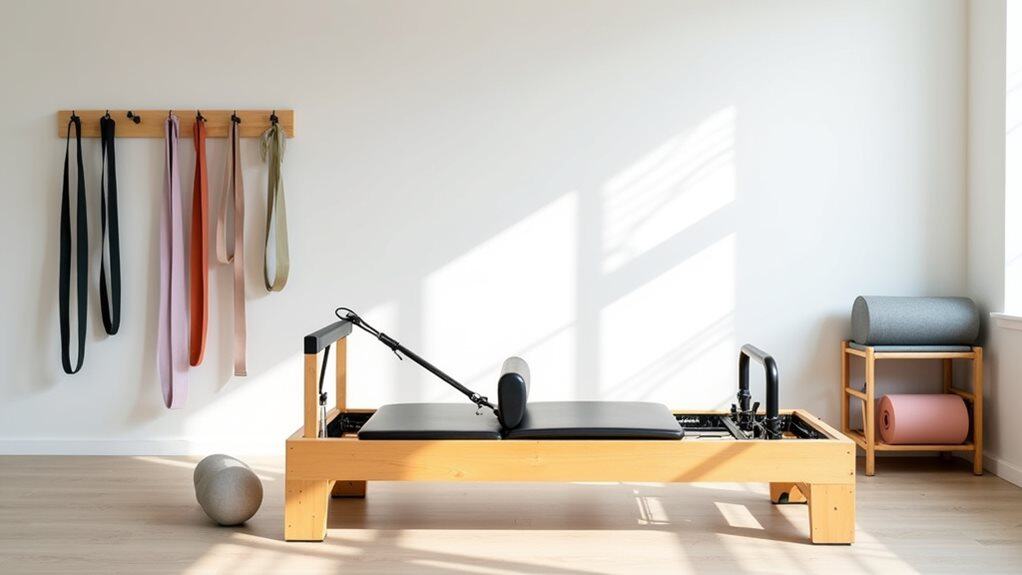Five key factors determine your muscle-building timeline as a 50-year-old woman. Your current fitness level and activity history establish your baseline capacity for strength gains. Menopausal hormonal changes, particularly declining estrogen and DHEA levels, affect your body's protein synthesis and recovery patterns. Your dietary choices, especially protein intake of 1-1.3g per kg of body weight, directly impact muscle development. Exercise consistency through 2-3 weekly strength training sessions enables progressive overload for continued adaptation. Quality sleep of 7-9 hours optimizes recovery and growth hormone production. Understanding these interconnected factors will reveal your muscle-building potential.
Current Fitness and Activity Level
When starting out with muscle building after 50, your current fitness level and activity patterns serve as critical baseline metrics for developing an effective training program.
Your existing fitness foundation directly influences how quickly you'll progress and what training intensity you can safely handle. If you've maintained regular physical activity, you'll likely adapt more readily to strength training protocols compared to someone who's been sedentary. Following the guideline of three resistance sessions per week optimizes your muscle-building potential.
Your current activity level also impacts muscle recovery patterns and determines your initial training frequency. For beginners, starting with 2-3 strength training sessions per week allows adequate recovery time while still promoting muscle growth. The natural decline in anabolic hormones makes muscle building more challenging but still achievable with consistent effort.
You'll need to implement progressive overload principles, gradually increasing weights and resistance as your muscles adapt, regardless of your starting point. If you're new to resistance exercises, begin with fewer sets and focus on proper form before increasing intensity.
Working with fitness professionals can help you accurately assess your baseline capabilities and design a program that matches your current fitness level.
They'll help you incorporate various exercises targeting different muscle groups while ensuring you don't overtrain, which becomes particularly important as muscle recovery needs change with age.
Hormonal Changes During Menopause
During menopause, significant hormonal fluctuations create unique challenges for muscle building and maintenance. As you enter this shift, typically between ages 45-55, your body experiences a substantial decline in estrogen and progesterone levels, while FSH and LH levels increase. These hormonal fluctuations directly affect your body's ability to synthesize and maintain muscle tissue.
The estrogen impact extends beyond reproductive functions, influencing how your body utilizes energy and maintains muscle mass. You'll notice changes in body composition as fat distribution patterns shift and muscle-building becomes more challenging. DHEA levels decline significantly during this period, which can further impact muscle development and strength gains. These changes can persist for 2 to 8 years as your body adjusts to the new hormonal environment.
Your body's reduced estrogen levels affect protein synthesis and muscle recovery, potentially requiring longer recovery periods between strength training sessions.
These hormonal changes also influence bone density and joint health, which can affect your exercise capacity and muscle-building potential. You'll need to account for the fact that your body now processes calcium differently and may experience increased joint stiffness.
Understanding these physiological changes is essential because they'll influence how you structure your strength training program, including exercise selection, intensity, and recovery periods to optimize muscle development during this shifting phase.
Diet and Protein Intake
Three key nutritional components drive muscle development for women over 50: adequate protein intake, proper meal timing, and overall caloric balance.
You'll need to consume 1 to 1.3 grams of protein per kilogram of body weight daily to support muscle synthesis and combat age-related muscle loss. This protein should come from high-quality sources like lean meats, fish, eggs, and dairy products, though plant-based options such as legumes can also contribute to your daily requirements. Working with a nutrition professional can help create a personalized eating plan that meets your specific needs.
A balanced diet is essential for maintaining the strength needed to perform exercises like wall push-ups and planks effectively.
Protein timing plays an essential role in muscle development. You'll maximize muscle protein synthesis by spreading your protein intake across multiple meals throughout the day, with particular attention to your post-exercise nutrition window.
Consuming a combination of protein and carbohydrates within an hour after your workout will support ideal muscle recovery and growth.
Your overall nutrient quality matters greatly. While meeting your protein needs, you'll need to maintain adequate caloric intake and include healthy fats for hormone production.
You should also prioritize proper hydration and minimize processed foods, as these factors directly impact your body's ability to build and maintain muscle mass during menopause.
Exercise Consistency
For women over 50, exercise consistency forms the cornerstone of successful muscle development. You'll need to commit to a structured strength training program of at least 2-3 sessions per week, maintaining this schedule for a minimum of 150 minutes weekly. This consistent workout schedule creates the foundation for progressive muscle adaptation and growth.
Your strength training sessions should incorporate compound exercises that target multiple muscle groups simultaneously, maximizing workout efficiency while promoting overall muscle development. Starting with exercises like overhead presses and rows helps establish proper form and builds foundational strength. As you progress, you'll need to gradually increase weights or resistance to maintain the challenge necessary for continued muscle growth. This principle of progressive overload is essential, though you should approach it cautiously to prevent injury. Working with a certified fitness trainer can help ensure proper form and technique while minimizing injury risk.
Include rest days between intense workouts to allow for proper muscle recovery and adaptation. You'll also want to integrate 30 minutes of moderate cardiovascular activity five days weekly to support heart health and endurance.
Monitor your progress regularly and adjust your workout schedule as needed to prevent plateaus. Remember that muscle development at 50+ typically occurs more slowly than in younger adults, making consistency even more vital for achieving your strength goals.
Sleep and Recovery Patterns
Proper sleep and recovery patterns play an essential role in muscle development for women over 50, with seven to nine hours of quality sleep being vital for ideal results. When you don't achieve adequate sleep duration, you'll experience up to 60% more muscle mass loss and create a catabolic environment that breaks down your hard-earned muscle tissue.
Deep sleep is particularly important because it triggers the release of growth hormone, which peaks during the first few hours of sleep. This hormone is fundamental for muscle repair and growth, especially as you age. Individual consultation may be necessary to optimize your hormone levels and muscle-building potential.
You'll need to optimize your sleep environment by avoiding caffeine before bedtime, reducing blue light exposure, and maintaining a consistent sleep schedule. Resistance training can significantly improve your sleep quality and duration more than cardio exercises alone.
If you can't achieve sufficient nighttime sleep, strategic napping can supplement your recovery. Consider 20-30 minute naps, particularly before workouts, to reduce stress and inflammation that could impede muscle growth.
However, don't rely on naps as a replacement for proper nighttime sleep. Track your sleep stages to confirm you're getting enough deep sleep, and maintain good sleep hygiene by consuming fiber-rich foods and avoiding alcohol, which can disrupt your sleep quality.
Frequently Asked Questions
Can Certain Medications Interfere With Muscle Building After Fifty?
Yes, various medication types can impair your muscle-building process. Statins, ACE inhibitors, antidiabetic drugs, and NSAIDs affect your muscle metabolism and recovery through different hormonal effects and biochemical pathways.
Does Having a History of Joint Replacements Affect Muscle-Building Potential?
You can still build muscle with joint replacements, but you'll need modified rehabilitation strategies and proper attention to joint health. Work with specialists to develop safe, effective exercises that protect your prosthetic joints.
How Does Stress Levels Impact Muscle Growth for Women Over Fifty?
Your elevated cortisol levels from chronic stress directly impair muscle growth by disrupting hormonal balance and protein synthesis. You'll need effective stress management techniques to optimize muscle development and maintain favorable anabolic conditions.
What Role Does Genetics Play in Muscle-Building Capacity After Menopause?
Your genetic predisposition interacts with hormonal influences during menopause, affecting muscle satellite cell function and protein synthesis rates. These inherited factors considerably impact your muscle-building capacity through estrogen-responsive gene expression pathways.
Should Muscle-Building Exercises Differ Based on Previous Pregnancy History?
While pregnancy effects don't require distinct exercise modifications, you'll benefit from addressing core stability and pelvic floor strength initially. Your recovery time after exercises may vary, but standard muscle-building principles remain universally applicable.
Final Thoughts
Building muscle at age 50 requires you to understand and enhance multiple physiological variables. Your baseline fitness, menopausal hormone fluctuations, and protein synthesis capabilities will greatly impact your progress timeline. You'll need to maintain consistent resistance training protocols while ensuring adequate protein intake (1.6-2.0g/kg body weight) and ideal sleep patterns (7-9 hours). Regular monitoring of these factors enables data-driven adjustments to your muscle-building strategy.




